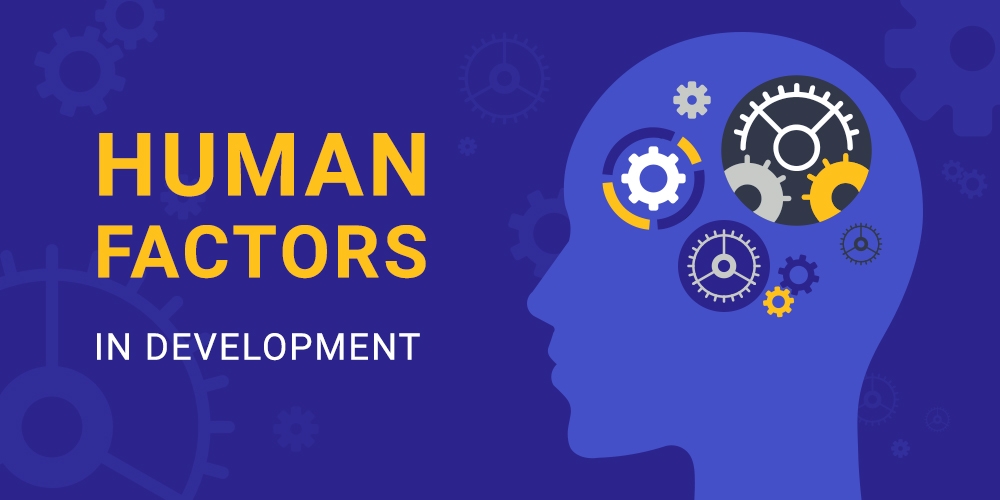Human factors: what are they?
The science of human factors makes a compelling case for becoming integral in the development of almost any product or service. Human factors can be defined as those aspects of human behaviour which influence the way in which a person interacts with a machine, device, piece of equipment, task process or so on.
It moves the conversation from what you envisage will happen in theory to what will actually happen in practice due to human traits, quirks, limitations and general characteristics.
As a field of study the rewards are tangible in that truly understanding human factors can help optimize the performance of any product or service as well as maximize human wellbeing.
It is used from the development of training programs to the development of medical devices, and its continued research and application is crucial to continued improvements in interventions.
Human factors or ergonomics is a discipline that comprises of three fields:
• Physical human factors
• Organisational human factors
• Cognitive human factors
There are also specializations to these categories like the case when physical human factors may include visual human factors, the cognitive ergonomics can also include usability, user experience engineering or human computer interaction. So, these are not the only fields in the human factors but they are the three main fields in human factor research or ergonomics.
There are many new terms coined in the process. Like, for example, user trial engineer is a term used to shortly describe a professonal who specializes in trials where users test the product or service - or anything that needs testing. The names and the terms may change but what human factor or ergonomics professionals do is still similar and they apply the understanding of the human factor to equipment or system design as well as the design of working methods which will then improve the safety and health as well as productivity and comfort of the humans that use or work on the products, services and systems.
There are also domains of specializations.
Physical human factors is the science of designing interaction of the users with the products, equipment and workplaces in a way that fits the users. It plays to the human anatomy and the characteristics that relate to the physical activity of humans. The principles designed by physical ergonomics have been widely used in design of both final, consumer products and industrial products and equipment. There are many risk factors to every product like mechanical pressure, injuries related to the equipment and products, force, posture, sedentary office environment and so on. Various things can happen like arthritis, carpal tunnel syndrome and so on. Pressure can make a device unusable for those who already have issues and there are many ergonomically designed products which are actually recommended for these people and that can prevent these issues.
“These jobs are also often involving activities like forceful exertion, heavy lifts, strange working positions, vibrating equipment usage and so on. Ergonomics program can actually reduce the compensation costs and increase their productivity as well as decrease employee turnover. Some mitigation solutions can involve both long term and short term solutions,” explains Dan Firtz, a tech blogger at OX Essays and Paper Fellows. They might involve awareness training, how the body is positioned, how the furniture and equipment works and so on. Some of the examples may involve sit and stand stations, computer accessories with soft surfaces, split keyboards and so on. The HR department can also analyse different things and ensure that the criteria is met and that the most problematic areas are focused on and fixed.
Human activity when safety is of paramount importance
A particularly critical field in which human factors must always be considered is safety. Advances in the development of health and safety identification and methods in almost every industry have revolutionized work practices, but accidents still can and do happen.
Workplace accidents continue to occur despite the plethora of rules and regulations, while airplanes will still occasionally crash, trains will sometimes derail and products will very now and again still cause harm.
The aviation industry is an interesting case in point. According to Boeing no less, 80% of airplane accidents are a direct consequence of human error (which must be distinguished from solely pilot error, because there are multiple ways in which human error can occur in the course of a flight).
With stringent regulations in place covering every aspect of aviation, it is significant that it is the behaviour of humans that ultimately create the most common problems. Interestingly, there are still not many aviation organizations that employ tools for the management of human factors, despite the fact the evidence points to them being the singularly most important issue.
How businesses integrate human factors
One of the reasons why many businesses fail to consider the relevance of human factors is because of the severe challenges faced in measuring them. At the coalface it may be deeply apparent that something is not working or the heightened risk potential, but it is how it is measured, planned for and ultimately integrated within working practices that counts.
The BSI’s research suggests that foreseeing issues through deep yet early-stage research would prevent the production of devices and instruments that fail to do what is required of them down to these human behaviors categorized in this article.
“What does this human factor research look like? The principal is to find an adequate quota of suitable end-users who can participate in the trial of the device. Of course, this is costly and time-consuming, two factors which may have limited its impact previously, but should never be a barrier to it happening. Organizations that understand this develop the products and services that continue to be useful and popular long after their introduction. We are talking here about a long-term solution, not about making a quick and easy buck,” argues Kim Stokes, a recruiter at Academized and Custom writing online.
Human involvement in industrial development
Human factors are not just relevant to what is, but to what will be. For example, the development of industry, mostly through the exponential use of technological advances, still hinges on these technologies interaction with humans. And of course, while speak is constantly of the danger that technology presents to employment, a negative atmosphere will only ensue. So here lies the heart of the matter: if humans are responsible for the very technology which will develop all aspects of industry and our day-to-day lives, yet human wellbeing is seen as being at threat to this development, how are these two concerns to be married?
It is vitally important that the design and implementation of new technologies is correct, and in order for this to be so, the way in which they will impact upon and be assimilated with humans needs to be understood to the nth degree. If human workers will be operating alongside these technologies, how will they dovetail, and what are the risks?
“In most cases, human skills and abilities will never become obsolete, so the technology exists to enhance these human attributes, and should operate as interventions when human limitations get in the way,” states Tom Harper, a project manager at StateOfWriting and Big Assignments.
This is why ergonomics, that is, the study of human efficiency in their workplace, is so critical, and must be factored in to the development of any aspect of technology that will be implemented in the working environment.
The role of humans in the workplace of the future
Ultimately, what does this all mean? First and foremost, the workplace of the future will no doubt look very different from how it does today.
That in itself should not be seen as a threat, and is a case in point of how human factors must and will be considered. Human buy-in is a crucial factor, because in nearly all circumstances, human participation will still be a core activity.
Future workplaces will be more mobile, varied and interactive, yet the best way of preparing humans for those workplaces is through the detailed understanding of human factors.
It is through the implementation and implication of human factors that skillsets will be developed and enhanced, how humans will be prepared for changing and mobile work environments, and how new tasks will ultimately be learned and carried out effectively, with the assistance of machines and technology.
Human factor research: how it can influence product design and development
So how will human factor research influence the design and development of these systems, processes, technologies, devices or whatever they may be?
First and foremost, it will be the decisive factor in whether humans ultimately are willing to work with these systems, machines and technologies. If a person rejects it based on the fickleness of the human mind, then that is a human factor that was never considered properly or ultimately prepared for.
Of course, it is not easy to do this – humans are complicated beings – but deep and early-stage research, combined with effective measurement tools, is the solution.
Email marketing expert Aimee Laurence is also a featured writer at various educational publications like Marketing assignment help and Management assignment help. Over the course of her career Aimee had devised countless marketing strategies, and she can also be found blogging at Boom Essays about her experiences online.



